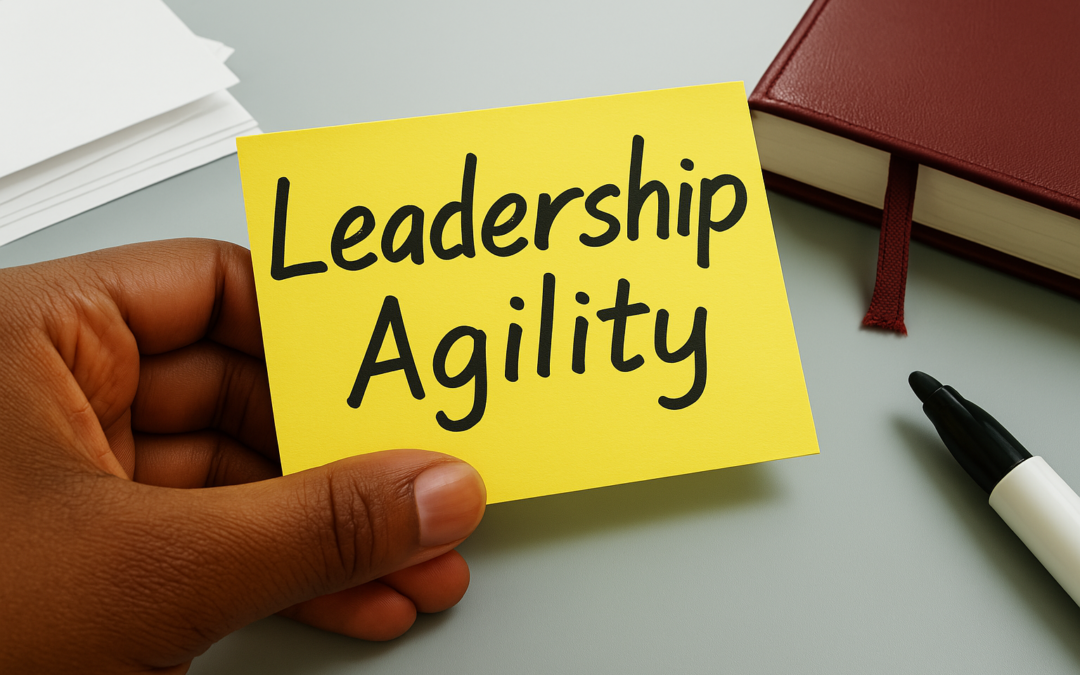
by Atiya Sheikh | May 25, 2025 | Board Members, Board Trustees, CEO, CFO, COO, CIO, General Managers, Heads of Divisions, Leadership Development
Resilience Starts at the Top: How Leaders Can Equip Their Businesses for Disruption
In an age of constant flux, where global shocks and rapid change have become the norm, the role of a CEO has evolved. Today’s leaders must move beyond traditional responsibilities and embrace a more dynamic title: Chief Resilience Officer.
Recent research from McKinsey & Company raises a pressing concern—84% of business leaders say they feel ill-equipped to handle future disruptions, and 60% of board members believe their organisations lack the preparation to face the next major crisis. Yet, amid this uncertainty, leaders can adopt clear, actionable strategies to build resilience and position their organisations for sustainable growth.
Understanding the Five Dimensions of Resilience
To lead effectively through disruption, CEOs must recognise that resilience spans multiple dimensions. McKinsey outlines four key areas:
-
Financial Resilience – The flexibility, liquidity, and access to capital organisations need to weather setbacks and seize opportunities.
-
Operational Resilience – The agility to pivot business practices swiftly and at scale.
-
Organisational Resilience – The cultural and structural strength that enables teams to adapt and recover from setbacks.
-
External Resilience – The strength of stakeholder relationships—including clients, regulators, and investors—that stabilise and support the business.
At inemmo, we believe organisations must also prioritise a fifth dimension:
-
Digital Resilience – The ability to adapt, protect, and thrive in an increasingly digital world. This includes countering cyber threats, embracing emerging technologies, sustaining operations through digital platforms, and enhancing digital capabilities across all levels of staff.
In our global leadership work, we regularly observe how digital fragility can undermine even the most robust strategies. Digital resilience is no longer just part of operational readiness—it has become a strategic imperative.
Embedding Resilience into Organisational Vision
High-performing companies often outperform their peers because their leadership teams align under a shared, resilient vision. CEOs must set this ‘North Star’—a guiding purpose that remains steady in turbulent times.
However, many organisations fail to communicate their vision consistently during uncertainty. CEOs must take the lead in recalibrating their messaging, ensuring it connects long-term ambition with short-term responsiveness. A resilient vision inspires confidence and unifies teams navigating ambiguity.
Linking Resilience Directly to Growth
Resilient businesses don’t wait for disruption to expose weaknesses—they plan ahead. McKinsey reports that 72% of high-performing CEOs set growth targets that exceed the market average. These leaders recognise that resilience acts not only as a shield but as a catalyst for progress and innovation.
Practical actions include scenario planning, stress testing, and using periods of calm to build future capabilities. When leaders treat resilience as a growth engine, they position their organisations to seize opportunities amid uncertainty.
Investing in People and ‘Full-Body’ Resilience
Organisational strength relies on more than systems—it depends on people. CEOs must build what McKinsey describes as “full-body resilience” by addressing all five dimensions in an integrated way. Strength in one area should support others when pressure builds.
This requires investment in the adaptability and well-being of individuals across the business. Leaders should prioritise hiring and developing people who remain agile, responsive, and solution-focused—even under pressure.
Strengthening Stakeholder Relationships
In a complex, interconnected world, CEOs must show up as visible, vocal, and values-led leaders. While many executives believe in corporate responsibility, few feel that organisations take meaningful action.
Effective leaders build external resilience by cultivating strong relationships with a wide range of stakeholders—suppliers, clients, policymakers, investors, and media. These relationships grow through authenticity, consistent communication, and the courage to lead conversations on critical issues.
Final Thought
At inemmo, we believe resilient leadership goes beyond managing risk—it requires a mindset shift. In moments of upheaval, CEOs who embrace this expanded role, align their people, adapt their strategies, and build external trust will guide their organisations toward long-term value and impact.
Is your leadership team ready to become resilience architects?
The Right Conversation Can Change Everything. Let’s Talk.

by Atiya Sheikh | May 25, 2025 | Board Members, Board Trustees, CEO, CFO, COO, CIO, General Managers, Heads of Divisions
Succession Planning: The Strategic Discipline That Shapes the Future
Leadership succession is not an event—it is a discipline. Done well, it secures continuity, strengthens organisational confidence, and positions businesses to adapt and grow. But handled poorly, it exposes gaps, disrupts momentum, and undermines long-term performance.
At inemmo, we work with boards and executive teams to treat succession planning as a vital thread of strategy. It is not about filling a vacancy; it is about building a pipeline of leaders prepared to guide the business through whatever comes next.
Embed Succession from the Start, Not the Exit
Succession planning should begin the moment a new CEO or senior leader steps into their role—not when they start thinking about stepping down. Organisations that excel in this space treat succession as an ongoing leadership responsibility, not a reactive process.
Embedding succession planning into the rhythm of executive oversight enables early identification of potential successors and helps ensure long-term readiness.. It allows leadership teams to make informed decisions, avoid last-minute scrambles, and ensure the future is always being shaped—not simply awaited.
The Next Leader Should Be Built for What’s Ahead
One of the most common missteps in succession is choosing someone who mirrors the current leader. While continuity has its place, it should not come at the expense of future readiness.
Boards and leadership teams must look beyond what works now because tomorrow’s challenges will be different. What capabilities will be essential as the business evolves? What leadership style will help the organisation respond to new market forces, emerging technologies, or global uncertainties?
Succession planning must be future-facing. It requires a clear, dynamic leadership profile—one that evolves alongside strategy, culture, and external shifts. Psychometric tools, behavioural assessments and executive development insights provide the evidence needed to identify not just high performers, but high-potential leaders prepared for tomorrow’s demands.
A Strong Handover Builds Confidence and Momentum
A leadership transition is not just about who comes next—it’s about how they are supported. Outgoing leaders play a vital role in enabling a smooth handover. When handled with transparency and structure, this transition builds confidence among investors, employees, and stakeholders.
It is essential that the incoming leader is given both backing and breathing space. A well-executed handover includes mentorship without interference, knowledge transfer without micromanagement, and public endorsement without overreach.
The real measure of a leadership legacy is not only in what was achieved—but in how the next chapter is made possible.
Succession Planning as a Leadership Culture
Truly resilient organisations treat succession planning as a core element of their leadership culture. It becomes part of how talent is developed, how strategy is sustained, and how growth is enabled over time.
At inemmo, we help organisations make succession planning part of the leadership dialogue, not a last-minute discussion. We support boards, senior teams and HR leaders to prepare the next generation of executives—not just to take over, but to take the organisation forward.
Succession is not about replacement. It’s about renewal.
The Right Conversation Can Change Everything. Let’s Talk.

by Joy Maitland | May 25, 2025 | Board Trustees, CEO, CFO, COO, CIO, General Managers, Heads of Divisions
Integration or Implosion? Winning the Culture Battle After a Merger
Mergers and acquisitions are often hailed as game-changing strategies to achieve rapid growth, scale innovation, and strengthen market position. But all too frequently, they fail to deliver the anticipated results. The missing link? Human experience.
At inemmo, our work with executive teams across multiple sectors has revealed a recurring truth: even the most financially sound and strategically aligned acquisitions can unravel when the employee integration journey is overlooked. The greatest risk in any merger is not just technological or operational misalignment—it is the disengagement of the very people expected to drive post-deal success.
The Human Cost of Poor Integration
Employees within acquired organisations often describe the experience as disorienting, isolating, and at times, deeply unsettling. These individuals—many of whom bring invaluable innovation, knowledge, and relationships—are too often left feeling voiceless, underutilised, and disconnected. One described the moment of acquisition news as “like a death in the family.” Such emotional fallout is not only widespread—it has lasting business consequences.
Where this disconnect persists, engagement plummets, productivity stalls, and attrition increases—sometimes for years. Alarmingly, even in cases where the acquisition brings together complementary capabilities, a poorly managed culture clash can erode the very value the deal aimed to create.
The Opportunity: Building a Unified, Respectful Culture
Creating a unified culture doesn’t mean enforcing uniformity. It means aligning behaviours, systems, and values in a way that respects the heritage of both organisations while moving forward with clarity. To achieve this, acquirers must place culture integration on equal footing with legal, financial, and operational priorities.
Based on insights from across the M&A landscape and inemmo’s leadership development expertise, five practices stand out:
1. Conduct a Dual-Sided Culture Assessment
Most firms assess the culture of the company they’re acquiring. Far fewer hold up the mirror to their own. This is a strategic misstep.
A meaningful culture assessment must explore both entities—mapping how they make decisions, manage risk, and engage with innovation. These insights enable leadership to anticipate friction points and clarify the path forward. Cultural differences, if left unexamined, can delay innovation, undermine collaboration, and stifle initiative.
2. Create a Clear, Human-Centred Culture Integration Plan
Integration must be more than a timeline—it should be a leadership commitment to clarity, dialogue, and empathy. Leaders must articulate not only what will change, but why. They should equip managers with the rationale, resources, and autonomy to bridge cultural gaps with authenticity.
This is especially true when legacy cultures hold prized traits—entrepreneurial energy, speed, creativity—that risk being stifled. As we’ve seen, when acquiring firms pause to explain their methods, rather than impose them, engagement and trust increase.
3. Map the Employee Journey—Before It Begins
A merger feels abstract until it becomes personal. Will their systems change? Who do they report to? How do they apply for leave?
Mapping the employee journey—across 12 to 24 months—allows organisations to prepare for real-life milestones and manage change compassionately. Whether it’s benefits queries, IT logins, or badge renewals, every interaction either builds or erodes trust.
Just as importantly, clarity must replace ambiguity. If certain decisions are still pending, say so. Transparency—even about uncertainty—is more reassuring than misleading certainty.
4. Empower Middle Managers as Culture Translators
Middle managers are the bridge between strategy and reality. Yet too often, they are brought in late, without the information or tools to lead their teams through change.
Equipping these leaders with decision rights, context, and regular access to senior integration teams transforms them into confident, credible guides. They need to be heard—early, often, and visibly—as they carry the message and pulse of the integration.
5. Stay Agile and Responsive to What Emerges
No matter how detailed the integration plan, new insights will emerge. Perhaps the culture is more risk-averse than anticipated. Perhaps legacy rituals, like Friday pizza gatherings, are core to team morale.
Success lies not in rigid execution, but in responsiveness. Build in review phases. Use pulse surveys. Act swiftly on what matters—however small it may seem. Integration is not a one-time event, but a dynamic process that requires real-time adjustment and human leadership.
Cultural Intelligence in Action
At inemmo, we believe cultural intelligence is a decisive advantage during M&As. Leaders who listen closely, communicate clearly, and integrate respectfully not only preserve value—they unlock it.
A successful merger is not just about combining balance sheets or operational systems. It’s about blending ambitions, aligning behaviours, and creating a shared story that people want to be part of.
The deal may be signed in the boardroom. But its true success is determined in the hearts and minds of employees—day by day, conversation by conversation.

by Joy Maitland | Mar 30, 2025 | CEO, CFO, COO, CIO, News & Articles
The Rosebud Phenomenon explains how past experiences—especially unresolved emotional wounds—fuel our ambition. It reveals the deep connection between personal history, professional success, and the pursuit of true fulfilment.
In today’s high-performance business environment, professionals chase success with unwavering focus. Success is widely seen as the ultimate benchmark. However, behind many top performers lies a deeper, often hidden force. This powerful motivator is rarely discussed in boardrooms or biographies. It’s here that the Rosebud Phenomenon offers a fresh and enlightening perspective.
What Is the Rosebud Phenomenon?
The Rosebud Phenomenon refers to the idea that a formative trauma, loss, or emotional void becomes the nucleus of ambition. These early experiences often drive us to achieve, push harder, and stand out. They can sharpen determination and shape professional identity. Yet, this same force may quietly limit long-term satisfaction.
The concept originates from the film Citizen Kane. In it, “Rosebud”—a childhood sled—symbolises lost innocence and a deep emotional need that was never resolved. Likewise, many professionals carry a silent narrative rooted in personal history. This narrative becomes the engine behind relentless performance.
A Double-Edged Sword
Understanding the Rosebud Phenomenon helps leaders and entrepreneurs look beyond surface-level motivation. On the one hand, it drives innovation, ambition, and resilience. On the other, it can keep individuals trapped in a cycle of never-enough.
Executives often feel caught in this paradox. The urge to prove themselves, to heal old wounds, or to rewrite personal stories can deliver impressive results. However, when the emotional source remains unexamined, the journey can lead to burnout, chronic dissatisfaction, or identity conflict.
For example, a leader who grew up feeling overlooked might build a wildly successful company—only to discover they still feel invisible.
The Link Between Meaning and Purpose
The Rosebud Phenomenon offers a clear lens to distinguish meaning from purpose.
Purpose tends to be external—a goal, a title, a mission. Meaning, however, is personal. It’s the internal story we attach to what we do and why we do it.
When professionals build their purpose on unresolved emotional meaning, the two can drift apart. This misalignment often explains why some high achievers feel empty despite checking every box.
They hit the targets. They gain recognition. But the satisfaction fades quickly—because the emotional need behind the success remains unmet.
Implications for Leadership and Growth
Recognising the Rosebud Phenomenon unlocks a deeper level of leadership. It encourages authenticity, emotional insight, and a more human approach to performance. By exploring this dynamic, leaders can align their ambitions with true well-being—not just metrics.
Here are three reflective questions to explore:
- What early experiences shaped my need to succeed?
- Does my definition of success reflect what truly matters to me?
- Am I chasing goals to fill a void—or to express genuine passion?
These questions help shift focus from achievement alone to a more sustainable and satisfying kind of success.
A Personal Note
Some years ago, I had the opportunity to attend a workshop with Dr Stewart Desson, founder of Lumina Learning. The session centred on Lumina Emotion—a tool designed to help individuals understand, adapt, and manage their emotions effectively, empowering them to think clearly and act with purpose. During one of the exercises, I experienced what I can only describe as my own Rosebud moment. It was deeply emotional, completely unexpected, and, if I’m honest, a little embarrassing—especially as a business psychologist who’s facilitated similar sessions myself. Yet in that moment, something shifted. My understanding of my own drivers turned upside down, and the clarity it brought was profound. That experience didn’t just stay with me—it quietly changed the way I view success, fulfilment, and what truly matters.
Final Thoughts
The Rosebud Phenomenon in business provides a compelling framework for rethinking motivation. It invites professionals to look inward—not just upward. In a culture that often celebrates output over insight, this shift is both timely and necessary.
For leaders who seek excellence and inner peace, understanding this dynamic offers a powerful advantage. True success doesn’t just come from what we achieve—but from understanding why we strive in the first place.
The Right Conversation Can Change Everything. Let’s Talk.

by Atiya Sheikh | Mar 30, 2025 | CEO, CFO, COO, CIO, News & Articles
What a 19th-century war game reveals about strategic thinking, adaptability, and decision-making for today’s senior business leaders.
In 1824, a young Prince Wilhelm of Prussia witnessed a military simulation that would go on to change the fortunes of his army—and perhaps the shape of Europe. Kriegsspiel, a war game designed with maps, wooden battalions, and probability tables, was more than a pastime. It became an engine of innovation. Under Wilhelm’s reign, this simulation helped shape military tactics that brought unexpected success in the Franco-Prussian War. Its continued evolution laid the groundwork for predictive logistics, strategic modelling, and ultimately the birth of modern game theory.
For today’s senior leaders, the lesson is clear: when complexity reigns, the ability to model reality—rather than simply react to it—becomes a defining advantage.
Simulating Complexity
The genius of Kriegsspiel was its ability to condense an overwhelming battlefield into a controlled, analytical environment. Its relevance today lies in its approach to complexity. Senior leaders navigating volatile markets, geopolitical shocks, and AI disruption face similarly intricate challenges. The temptation is to act decisively and instinctively—but modelling, simulation, and structured experimentation are far more effective tools.
The most forward-thinking organisations are already building internal “war rooms” that operate in much the same way. They use scenario planning not simply to forecast risk, but to rehearse resilience. Supply chain breakdowns, cyber threats, and consumer shifts are gamed out with cross-functional teams, enabling adaptive strategies long before crisis strikes.
The Leadership Mindset Shift
But the power of simulation lies not in the models alone—it lies in the mindset it cultivates. Prince Wilhelm didn’t simply mandate the use of Kriegsspiel for entertainment. He institutionalised it as a learning tool, embedding it into the professional development of every officer. In doing so, he transformed a military culture from rigid tradition to experimental agility.
Modern business leadership demands a similar shift. Organisations that treat uncertainty as a problem to eliminate will remain brittle. Those that treat it as a landscape to explore—one where tactics can be tested, recalibrated, and refined—will be better placed to navigate transformation with confidence.
This requires humility as much as ambition. Leaders must be willing to ask: What don’t we know? Where might we be wrong? Which assumptions should we challenge? These questions are uncomfortable, but they’re also the entry point to deeper strategic insight.
Models Are Not the Territory
Still, simulation has its limits. Just as Kriegsspiel compressed the battlefield into a tidy map, modern tools—from spreadsheets to digital twins—are simplifications of reality. Kelly Clancy, in her wide-ranging study of how games shape perception, warns that the map can begin to distort the territory. Overreliance on models can lead leaders to prioritise what is measurable over what is meaningful.
The same caution applies to the way game theory and behavioural economics have entered boardroom thinking. When human behaviour is treated as a matter of incentives alone—as though employees, customers or partners are pure rational actors—organisational strategy risks becoming divorced from lived experience.
The best leaders recognise the utility of these models without being seduced by their elegance. They combine data with judgement, logic with empathy. They understand that metrics are tools, not truths.
Designing for Adaptability
In today’s digital environment, game-like mechanisms are everywhere. Reputation systems, social scoring, and algorithmic feedback loops all shape how value is perceived and decisions are made. Businesses too often absorb these mechanisms passively—optimising for clicks, engagement, or customer “loyalty”—without stepping back to ask whether the game they are playing is the one they ought to win.
Leadership today must be more deliberate in shaping the rules of engagement. This means designing organisations not just for efficiency, but for adaptability. It means rewarding learning, not just output. And it means recognising that agility is not the same as chaos—just as improvisation in jazz is rooted in deep discipline.
What a 19th-century war game can teach us about 21st-century leadership
What can a 19th-century war game teach us about 21st-century leadership? More than we might expect. In an age where strategy must be as fluid as the challenges it seeks to overcome, simulation becomes more than a technique—it becomes a habit of mind.
To lead effectively today is to engage with complexity on its own terms. Not to flatten it, ignore it, or hope it goes away. But to step inside it, play it out, and emerge with clearer thinking and sharper intent.
The Right Conversation Can Change Everything. Let’s Talk.

by Atiya Sheikh | Mar 30, 2025 | CEO, CFO, COO, CIO, News & Articles
What makes teamwork effective—and why it fails? In the workplace, no matter the industry—from healthcare and education to finance and tech—success is rarely the result of individual brilliance alone. It’s teams that deliver the results.
But what separates high-performing teams from those that struggle? Why do some groups work like clockwork while others fall into confusion, miscommunication, and missed deadlines?
Welcome to the psychology of teamwork—a field that uncovers what really goes on beneath the surface of collaboration, and how you can build better teams that consistently deliver.
Why Teamwork Is More Complex Than It Looks
Teamwork may sound like a soft skill, but it’s a sophisticated blend of group dynamics, leadership, communication, and role clarity. Psychology first began exploring teamwork through the lens of group identity: how we define ourselves through the teams we’re part of, and how we behave differently when we’re in a group versus acting alone.
Over time, the field evolved. Researchers now examine how teams form, how they make decisions, what makes them efficient—and what makes them fall apart.
When Teamwork Fails: A Real-World Scenario
Let’s take an example from the retail banking world—though the same principles apply across industries.
A customer services advisor meets with a client applying for a mortgage. The standard process involves the advisor gathering initial details and booking a follow-up with a mortgage adviser, who then conducts affordability checks and submits the formal application.
In this case, the advisor assumes the adviser will confirm all financial documentation. Meanwhile, the adviser—new to the branch—believes those checks have already been handled. A key document is missed, the application is delayed, and the client becomes frustrated.
No one was careless. But a lack of shared understanding and clear communication led to an avoidable error.
The Three Pillars of Effective Teamwork: Collaboration, Coordination, Communication
At the heart of any effective team are three essentials:
- Collaboration
True collaboration isn’t just working side-by-side—it’s aligning on a shared goal and appreciating the value of different perspectives. For instance, in a project team, one member might spot a client risk others overlook due to their specific expertise. Strong collaboration means their voice is heard and considered.
- Coordination
Teams must be clear on roles, responsibilities, and timing. Who’s doing what—and when? Without proper coordination, even simple tasks can fall through the cracks, especially in industries with tightly sequenced workflows like healthcare, finance, or manufacturing.
- Communication
Poor communication is the most common cause of team breakdowns. It’s not just about talking more—it’s about ensuring that information is accurate, timely, and reaches the right people.
Why Every Team Needs a Leader—But Not Always the Same Kind
Leadership style can make or break a team. Broadly speaking, there are two main styles:
- Democratic leadership: values group input, ideal for building trust and motivation.
- Autocratic leadership: makes decisions quickly, useful in high-pressure or time-sensitive settings.
The best leaders adjust their approach based on the team’s needs and the task at hand. Interestingly, research shows that gaining power tends to shift people toward more independent thinking—often reducing their willingness to consult others. This is true for both men and women, though women leaders often maintain a stronger group orientation even as they rise.
What Goes Wrong in Group Decisions? Two Common Pitfalls
- Groupthink
This occurs when teams avoid conflict to maintain harmony. Members stop questioning decisions—even bad ones. It’s how warning signs get ignored and poor choices are rubber-stamped. Think of a team launching a flawed product because no one wants to speak up.
- Group Polarisation
Sometimes, groups make more extreme decisions than individuals would. A cautious team becomes overly conservative, or a confident team takes bigger risks than any one member would suggest alone. It’s a distortion of reality that comes from collective confidence—and it can backfire.
Size Matters: Why Smaller Teams Often Perform Better
The ideal team size? Around five people.
Once a team grows beyond that, accountability tends to blur. People assume someone else will take responsibility. This leads to social loafing, where effort drops because everyone believes others are picking up the slack.
In large organisations, this problem scales. When something goes wrong, individuals are quick to say, “That wasn’t my area.” The collective “we” dissolves, replaced by a flurry of self-preservation.
The Cultural Side of Teamwork
Teamwork isn’t just psychological—it’s cultural. In Western countries, the individual is often seen as the core unit. In Eastern cultures like Japan or South Korea, the group comes first.
This plays out in how accountability is assigned. In Europe or the US, a failed initiative may be traced to a single manager. In Japanese firms, the entire team may take collective responsibility.
Understanding these cultural differences is vital, especially for global teams.
How to Build a High-Performing Team
Strong teams don’t come together by chance—they’re built deliberately. Here’s how:
- Keep teams as small as possible for the task
- Define clear roles and responsibilities
- Select members for both technical ability and interpersonal skills
- Create psychological safety where people feel safe speaking up
- Encourage empathy and perspective-taking
In some industries, exercises that ask team members to “step into each other’s shoes” have shown real value. For example, asking a team leader to write from the perspective of a frontline employee can open up new insights into how decisions are experienced on the ground.
Diversity Isn’t Just a Buzzword—It’s a Necessity
Teams that are too similar in mindset, background, or personality often suffer from groupthink. In sectors like consulting or investment banking, hiring from the same profile pool can reduce the range of ideas and increase competition within teams.
The strongest teams are diverse in thought, experience, and working styles—and know how to leverage that difference rather than suppress it.
Final Thoughts: The Future of Work Is Team-Based
Whether you’re delivering financial services, leading a healthcare team, managing a creative agency, or running a non-profit, your results depend on how well your team works together.
The psychology of teamwork offers more than theory—it gives us a framework to build better collaboration, avoid common pitfalls, and unlock real performance.
What makes teamwork effective—and why it fails? Because in the end, success isn’t just about having great people.
It’s about building great teams.
The Right Conversation Can Change Everything. Let’s Talk.
See Harvards Business Review

by Joy Maitland | Mar 30, 2025 | CEO, CFO, COO, CIO, News & Articles
Self-aware Leadership Development
Leadership, as someone once wrote, is “one of the most observed and least understood phenomena on earth.” That line has stood the test of time—and for good reason. For all our progress, self-aware leadership development remains a complex challenge. We often recognise great leadership when we see it, but struggle to define it or replicate it with certainty.
In business, discussions around leadership usually orbit three familiar themes:
- How leaders think, act, and influence
- How people respond to leadership and engage with it
- The systems and environments in which leadership takes shape
Of these, it’s the leader themselves who still attracts the most attention. We’re fascinated by personality, presence, and the seemingly unteachable “it” factor. The old debate lingers: are great leaders born, or can they be developed?
Figures like Field Marshal Montgomery believed leaders needed “infectious optimism” and visible resolve, even in moments of doubt. Henri Fayol saw leadership as careful planning and execution. David Ogilvy celebrated the complicated character—someone confident, never petty, and not shaken by defeat. These views, though dated, still echo in how we think about leadership today.
But let’s be honest: leadership in the modern world looks very different.
The Shift: From the Heroic to the Human
In today’s organisations, leadership isn’t about being the loudest or most dominant voice in the room. It’s about presence, perspective, and adaptability. Leadership is no longer a role reserved for the chosen few—it’s a practice that can be shaped, refined, and strengthened over time.
This is exactly the thinking behind Lumina Leader, a powerful psychometric tool created by Dr Stewart Desson, a business psychologist and founder of Lumina Learning. Unlike older models that place people into rigid categories, Lumina Leader embraces complexity. It explores how personality influences leadership behaviour—and how those behaviours shift in everyday settings, under pressure, and at our best.
At inemmo, we use Lumina Leader to help leaders discover their natural style, their leadership strengths, and where they may overextend, especially under stress. It supports self-awareness in a structured, evidence-based way—making the invisible aspects of leadership visible and actionable.
Structure Still Matters
Of course, leadership isn’t only about personality. Some of the most effective leaders in history—like Alfred P. Sloan at General Motors—succeeded because they understood systems. They built solid structures and equipped others to thrive within them. In contrast, individuals with star power but little strategic depth often struggle to sustain success.
The best leaders today combine both: an understanding of themselves and the ability to shape systems around them. They know when to step forward, when to step back, and how to align people around shared goals.
Leadership vs. Management: A False Divide?
Abraham Zaleznik, writing in Harvard Business Review, famously argued that leaders and managers are fundamentally different creatures. Managers seek stability. Leaders seek movement. But in today’s world, that binary feels dated. The most effective leaders draw from both disciplines—balancing strategic clarity with empathy, structure with creativity.
Warren Bennis, one of the great thinkers on leadership, found that successful leaders consistently pay attention to what matters, define direction, and bring people along with them. It’s less about certainty and more about alignment.
So, What Now?
Leadership is evolving. It’s becoming more inclusive, more psychologically aware, and more context-driven. Tools like Lumina Leader are part of this evolution—helping leaders move beyond vague ideals and towards real understanding.
In practice, this means:
- Knowing your natural strengths and how others perceive them
- Recognising how you behave under stress—and where it may trip you up
- Learning how to stretch your style to meet the needs of different situations and people
Above all, it means understanding that leadership isn’t a fixed trait or a job title. It’s a living, breathing process—something shaped by reflection, experience, and honest feedback.
So, the next time we talk about leadership, maybe we should look beyond the myths and focus on the mindset. The truth is, leadership isn’t about being perfect. It’s about being real, being aware, and being ready to grow.
The Right Conversation Can Change Everything. Let’s Talk.

by Joy Maitland | Mar 2, 2025 | Board Trustees, CEO, CFO, COO, CIO, Managing Directors, News & Articles
Brand loyalty is more than just repeat purchases—it’s a powerful driver of business resilience and long-term growth. A prime example is the automotive industry. General Motors (GM) recently secured the S&P Global Mobility Award for Overall Loyalty for the tenth consecutive year, proving that a well-established reputation and a consistent customer experience can make all the difference.
Why Brand Loyalty Matters for Business Leaders
For business leaders, loyalty isn’t just a marketing buzzword—it’s a strategic asset. Companies that build strong relationships with their customers gain distinct advantages:
- Stability in Uncertain Times
When economic conditions shift or competition heats up, a loyal customer base provides a buffer. Customers who connect with a brand on a deeper level are less likely to be swayed by short-term price changes or alternative options.
- Lower Costs, Higher Returns
Winning over new customers is expensive. Keeping existing ones is far more cost-effective and leads to higher lifetime value. A strong customer base reduces reliance on costly acquisition campaigns and drives steady revenue.
- Reputation and Influence
Satisfied customers become your best marketing tool. They spread the word, leave positive reviews, and recommend your brand to others—helping you expand your reach without additional investment.
GM vs Tesla: A Study in Contrasts
GM’s commitment to quality and innovation has earned it long-standing customer trust. The company’s U.S. electric vehicle (EV) market share climbed to 12% in late 2024, doubling from the previous year. Consumers are responding to GM’s expanding EV range, offering more choice and accessibility. More importantly, GM understands that loyalty isn’t just about selling cars—it’s about building an ecosystem that keeps customers returning, from service plans to seamless integration with new technologies.
Tesla, on the other hand, is learning the hard way that brand prestige alone doesn’t guarantee continued devotion. European sales plummeted by nearly 50% in early 2025, leading to an 8% drop in stock value. The electric vehicle market is becoming more competitive, and Tesla faces increasing pressure from Chinese manufacturers such as BYD and XPeng, who offer high-tech alternatives at competitive prices. On top of that, uncertainties around government incentives and Tesla’s own pricing strategy have led some once-loyal customers to explore other options.
The contrast is clear: GM has successfully evolved its brand to keep customers engaged, while Tesla is struggling to adapt to shifting market conditions. Even the most innovative companies must actively nurture customer relationships to maintain loyalty.
How to Build Lasting Loyalty
To keep customers engaged and committed, businesses need to focus on three key areas:
- Consistency is King
Customers stick with brands they trust. Delivering reliable quality, service, and experiences is non-negotiable.
- Meaningful Engagement
Loyalty doesn’t stop after a sale. Strong after-sales support, personal touches, and ongoing communication keep customers invested.
- Authenticity Wins
Customers can spot insincerity a mile away. Transparency, ethical practices, and a genuine commitment to customer needs build lasting trust.
Loyalty: The Ultimate Competitive Edge
In an unpredictable world, brand loyalty is what separates businesses that thrive from those that struggle to stay relevant. Companies that prioritise customer relationships alongside innovation and operational excellence will always have the upper hand.
Tesla is facing a wake-up call—will it adjust course and reconnect with its customers, or will loyalty continue to erode? And in your business, are you doing enough to ensure customers stay with you, even when new competitors enter the market?
How is your organisation strengthening its brand loyalty strategy?
The Right Conversation Can Change Everything. Let’s Talk.

by Atiya Sheikh | Mar 2, 2025 | Board Members, CEO, CFO, COO, CIO, Heads of Divisions, Managing Directors, News & Articles
Boeing was once a leader in aerospace innovation, symbolising excellence in engineering and manufacturing. Today, it faces a crisis driven by leadership decisions, corporate strategy, and technical failures. The company’s struggles serve as a warning to senior executives across industries—short-term decision-making and an excessive focus on financial metrics can weaken a company’s core strengths, with lasting consequences.
The Risks of Prioritising Shareholder Value Over Long-Term Stability
One of Boeing’s biggest mistakes was prioritising shareholder value over its core operations. The company spent an estimated $68 billion on share buybacks between 2010 and 2024. While these decisions pleased investors in the short term, they weakened Boeing’s ability to invest in research, quality control, and supplier relationships.
Instead of focusing on innovation and product excellence, Boeing’s leadership prioritised financial engineering. The consequences have been severe: supply chain failures, declining safety standards, reputational damage, and financial losses.
The lesson is clear: financial success should result from strong leadership, not be the sole focus of corporate strategy. Companies that chase short-term stock market gains at the expense of sustainable growth put their foundations at risk.
The Consequences of Outsourcing and Disengaged Leadership
Boeing’s reliance on outsourcing and offshoring aimed to streamline operations and reduce costs. In reality, it created a fragmented supply chain with serious quality control issues.
The 787 Dreamliner illustrates this problem. Boeing designed it with a highly outsourced production model, sourcing 30% of components from outside the US, compared to just 5% for the 747. Management assumed external suppliers would uphold Boeing’s engineering standards. Instead, a lack of direct oversight led to production delays, technical flaws, and costly redesigns.
Many industries have followed a similar path, prioritising cost-cutting over quality and control. The lesson for senior leaders? A company should never outsource its core competencies. While strategic partnerships and global supply chains have benefits, they must be carefully managed to maintain operational integrity.
Leadership and Its Impact on Organisational Culture
Boeing’s cultural shift stems from two major decisions:
- The 1997 Merger with McDonnell Douglas – This merger introduced a more aggressive, Wall Street-driven mindset. The company moved away from its legacy of engineering excellence and safety. Many analysts link this cultural shift to Boeing’s current struggles.
- The 2001 Relocation of Boeing’s Headquarters – Moving the headquarters from Seattle to Chicago distanced executives from frontline operations. This physical and cultural separation weakened leadership’s connection with engineers and production teams.
These decisions highlight an important lesson: leadership shapes corporate culture, and executives must remain engaged with core operations. The most successful organisations ensure that senior leaders stay closely connected to their people, processes, and products.
Lessons for Today’s Business Leaders
Boeing’s challenges are not unique to the aerospace sector. Industries such as technology, finance, healthcare, and manufacturing face similar pressures to cut costs, improve efficiency, and satisfy investors. However, as Boeing’s experience shows, prioritising efficiency over strategic investment can create long-term instability.
Key takeaways for executives and senior managers:
- Sustainable success requires long-term vision – Short-term financial gains should never compromise operational excellence and innovation.
- Outsourcing must be measured, not excessive – While external partnerships can improve efficiency, businesses must retain control over their most essential processes.
- Leadership must stay connected to the core business – Disengaged executives risk losing sight of the organisation’s purpose and values.
- Culture is a vital asset – A strong, mission-driven culture enhances resilience during crises.
A Path to Recovery?
Boeing’s new CEO, Kelly Ortberg, appears to recognise the need for change. His decision to base himself in Seattle rather than the company’s Arlington, Virginia, headquarters signals a return to hands-on leadership. His approach—prioritising safety, quality, and direct engagement—could help restore Boeing’s credibility.
For leaders across industries, Boeing’s story is a reminder that business success is not just about financial performance. It is about building a company that can stand the test of time.
How is your organisation balancing financial priorities with long-term sustainability?
The Right Conversation Can Change Everything. Let’s Talk.

by Atiya Sheikh | Mar 2, 2025 | Board Members, CEO, CFO, COO, CIO, News & Articles, Senior Managers, Women Leaders
Modern business thrives on rapid digital transformation, where data is more than just numbers—it is the foundation of innovation and operational success. Without trust in data, even the most advanced AI systems can mislead organisations, causing financial losses and damaging reputations. Recent research highlights this risk: a 2024 Gartner study estimated that poor data quality drains 20–35% of operating revenue, while a Forrester report found that businesses lose 22% of revenue due to data inaccuracies. As generative AI (Gen AI) reshapes industries, organisations must strengthen data trust to harness its full potential.
Data as a Strategic Asset
Reliable data enables leaders to make smarter decisions and drive innovation. However, inaccurate or inconsistent data can lead to costly mistakes, such as incorrect pricing, flawed stock forecasts, or misallocated revenue. These errors can result in substantial financial losses and reputational harm. A McKinsey survey found that 65% of organisations now use Gen AI to enhance decision-making, nearly doubling its adoption in just one year.
Businesses must establish sound data governance to mitigate risks. This requires more than deploying advanced technology; it involves nurturing a data-driven culture and investing in staff training. By standardising data management practices and implementing strong security measures, organisations can transform raw data into a strategic advantage.
Unlocking Efficiency and Innovation with AI
AI integration is already reshaping industries. In customer call centres, Gen AI has reduced transaction times by up to 80% while increasing customer satisfaction by 20%. In aerospace, defence, manufacturing, and automotive sectors, AI-powered 3D modelling accelerates product design and production. Meanwhile, digital twins revolutionise supply chain management.
A global Statista report found that 57% of organisations expect AI to drive efficiency and innovation. By leveraging AI and automation, companies optimise processes and unlock new opportunities. These range from personalised customer experiences to enhanced ESG (Environmental, Social, and Governance) reporting, which supports sustainable growth.
Building and Maintaining Data Trust
To fully capitalise on AI, organisations must first assess their data quality. Identifying gaps and creating a clear improvement strategy are essential steps. A strong governance model should define roles, responsibilities, and processes that safeguard data integrity. Studies show that companies with robust data governance are 40% more likely to outperform competitors.
Upskilling employees is equally important. As AI-driven operations expand, collaboration between data teams and business units ensures data remains accurate, consistent, and secure.
Regulation, Ethics, and Responsible Data Use
Once data trust is established, maintaining it requires strict attention to regulation and ethics. AI technologies now detect anomalies, reduce manual errors, and predict trends, automating data quality checks. However, ethical considerations remain essential. Organisations must implement safeguards against biases in AI algorithms, ensuring transparency in data use and accountability in AI-driven decisions. Understanding a dataset’s origin—its lineage—reinforces transparency and responsible usage, ultimately strengthening trust.
Looking Ahead: A Data-Driven Future in 2025 and Beyond
As Gen AI continues expanding, its influence will grow stronger. The UK government’s AI Opportunities Action Plan, introduced in January, highlights data’s role in creating jobs, driving innovation, and increasing productivity. With global AI investments rising, the strategic value of data integrity becomes even clearer.
In 2025, businesses that enhance data trust will lead successful AI adoption and improve performance. Organisations that prioritise secure, accurate, and transparent data will protect their operations while unlocking new opportunities for growth and innovation.
There is no substitute for data you can trust. How is your organisation ensuring data integrity in an AI-driven world? By investing in strong governance, ethical AI practices, and continuous upskilling, businesses can turn data challenges into competitive advantages in an increasingly digital world.
The Right Conversation Can Change Everything. Let’s Talk.










